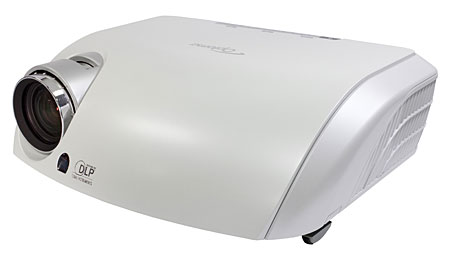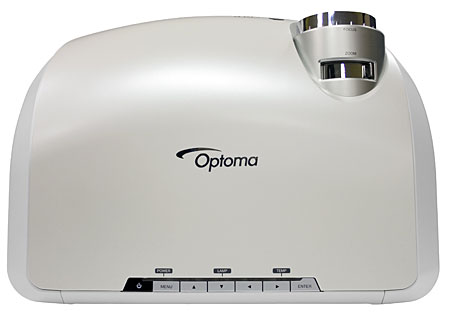Optoma HD8000 1080p DLP Projector

Optoma knows this. Its new HD80 single-chip DLP design, at $2,699 (with a current replacement lamp cost of $349), slides comfortably into this niche.
The projector we received for review, however, was the HD8000. At $3,199, the latter adds ISF day/night modes designed to be used by a custom calibrator and then locked so they cannot be tampered with. The HD8000 is also sold exclusively through custom installer channels, while the HD80 is available from more conventional sources. I did not test the special ISF modes, but apart from these the two projectors are functionally identical.
In For a Penny
Higher-end Optoma projectors come with an (excellent) external processor and video switcher. That's not possible at this price point, so all video processing is performed at 10-bits inside the HD8000, using video processing from PixelWorks. All the inputs are located on the back of the projector.
With two HDMI jacks plus a DVI connection, the Optoma has a more than generous complement of digital connections. It also sports component, composite and S-Video inputs, a +12V trigger, and an RS-232 jack. And the HD8000 even has a Kensington Microsaver Lock Port to keep gnomes from running off with it—a unique feature (in my experience) for a home theater projector.

The lens zoom and focus are both manual. There is no lens shift feature, either vertical or horizontal, and the high throw angle means that for a perfectly rectangular image the projector needs to be mounted either below the bottom of the screen (a hassle for a table mount) or above the top of it (useful for a ceiling mount). Otherwise you will have keystone distortion (with the image a trapezoid rather than perfectly rectangular). The HD8000 does have a keystone control to compensate for this, but we recommend against using keystone controls if at all possible; they compromise resolution.
The HD8000 uses a 7-segment color wheel (R/G/B/neutral density/R/G/B) operating at 6x the video refresh (frame) rate. For whatever reason, I found the Optoma somewhat less prone than average to the "rainbows" that afflict all single chip DLP projectors I've reviewed to one degree or another (I'm very sensitive to this artifact; not everyone is).
The control panel is located at the top rear of the projector. It includes several very bright LED indicators, which come on whenever a control input is made, but fortunately switch off after the action is complete.
There's a large air exhaust vent on the Optoma's right side (as you face the front). It not only pours out a lot of very warm air, but also leaks light from the projector's relatively small case, as well. The light leakage isn't bright enough to be obtrusive if the projector is located behind the viewing area, or is well above eye level, but both the light and the heat exhaust will need to be considered when deciding where to site the unit. When I was performing the test bench measurements I settled in at the right rear of the projector as I usually do, but before long things got a bit warm! Fortunately, summer was over.
There's another issue to the heat exhaust as well. Optoma notes that the projector includes something called O2 Air Photo Catalyst air purification technology. They don't explain exactly what it is, but previous Optoma projectors have emitted a pungent odor that can become very unpleasant in a small, poorly ventilated room. Unfortunately, the HD8000 is no different, air purification or not. The only other projectors in my experience that emitted noticeable odors were from Sharp, and in the most recent Sharp PJs the problem has disappeared with use. As of this writing our Optoma has about 35 hours on it. The odor is still there, but does appear to be less pronounced than when I first fired it up.
While all of the image adjustments may be accessed through the on-screen menus, the most important functions have direct access buttons on Optoma's excellent remote. All of the buttons are backlit, and the ones that don't have their function written in English on the buttons themselves have reasonably clear icons that specify their use.
The main video controls include the usual: Contrast, Brightness, Color, Tint, Sharpness, and Mode. There are five modes: Cinema, Brightness, TV, sRGB, and User. I stuck with User, and adjusted each control for the most accurate image possible.
There are also several Advanced controls: Noise Reduction, Gamma, and Degamma. The latter actually produces changes similar to that of the Gamma control, but with coarser steps. I set it on its Film option and left it there.
There's also True Vivid, a four-position control said to "enable the projector's vividness to be significantly increased." Edge Enhance does what its name implies. B/W Extension (not available on the HDMI or DVI inputs) stretches the black and white levels to "increase the contrast." And Color Temp provides selection of either Warm, Mid, Cold, or User. The latter offers full control (in the User menu) of red, green, and blue at both the high end (Gain) and low end (Bias) of the brightness range.
There are the usual aspect ratio selections. An additional option called Auto235 is mentioned in the manual. It's designed to provide image stretch for use with an outboard anamorphic lens, but this has not yet been implemented (nor has a related control called Anamorphic Lens, which is also mentioned but is similarly absent).
There are a variety of additional controls, including Overscan (leave it on zero if possible), Edge Mask (which can be used to mask off noise at the edge of the image without the resolution-reducing effect of overscan), H and V Image Shift (not the same as, or a substitute for, lens shift), V Keystone, Color Space (YCbCr will be correct for most video sources), and Signal Controls that provide an added range of adjustments but appear only with analog signals.
The HD8000 also has a 16-step, manually adjustable iris, Image AI, which is said to improve the contrast "by optimizing the brightness of the lamp according to picture content," and a Brite Mode for the projection lamp (Off is the best setting for video use).
The manual mentions a 48Hz control to display 1080p/24fps inputs at a 48Hz refresh rate, but that control has been omitted. Instead, the projector automatically recognizes when it receives a 24Hz input and frame doubles it to 48Hz with no user action required.
You can save separate video settings for each analog input, and a different setting for the HDMI and DVI digital inputs as well. But the HDMI settings are global across both HDMI inputs; you cannot save separate settings for HDMI 1 and HDMI 2.
The Optoma is relatively quiet in normal operation, though no record setter. It's noisier in the Brite Mode, in the High Altitude setting, or with Image AI engaged, all of which increase the fan speed. But I never felt the need for any of those features.
Viewing
The HD8000's video processing is among the best I've seen. It's 480i-to-1080p upconversion was pristine on all of my standard deinterlacing/scaling tests, from the HQV Benchmark test DVD, where it earned mostly excellent results (apart from a score of good on one of the jaggies tests and poor on the 2:2 cadence test). It also passed the Gladiator test (chapter 12, the Coliseum flyover) and the pan across the rooftops at the beginning of Star Trek: Insurrection with nary a squiggle or a jagged edge.
On the HD side, it properly deinterlaced 1080i to 1080p with both video and film-based test patterns. It also recognized and dealt with 3/2 pulldown on the film deinterlacing test, and passed our current favorite real-world test at either 1080p/60 or 1080p/24: the Vatican wall and steps in chapters 7 and 8 of Mission Impossible 3.
I did all of my viewing evaluations, apart from the test bench measurements of the component input, over HDMI.
- Log in or register to post comments




































































